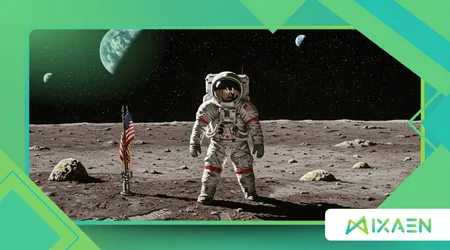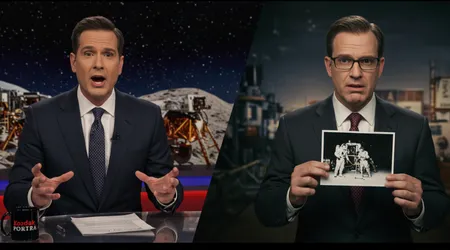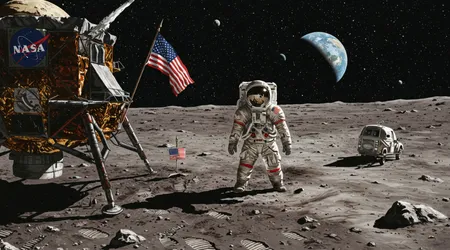The Moon Landing Hoax Debate: Why It Still Exists Today

The Moon Landing Hoax Debate captivates imaginations, fueling skepticism about one of humanity’s greatest achievements.
Anúncios
On July 20, 1969, NASA’s Apollo 11 mission landed Neil Armstrong and Buzz Aldrin on the lunar surface, a triumph watched by millions.
Yet, decades later, conspiracy theories persist, questioning the mission’s authenticity. Why does this debate endure in 2025?
Distrust in institutions, media influence, and gaps in public understanding of science keep The Moon Landing Hoax Debate alive.
This article explores the roots of skepticism, dissects key arguments, and examines why this controversy remains relevant.
Through a lens of reason, we’ll navigate the facts, myths, and cultural forces at play. Ready to unravel this enigma? Let’s dive into the shadows of doubt and the light of evidence.
The Apollo 11 mission was a defining moment. It showcased human ingenuity and marked a victory in the Cold War space race.
But skepticism emerged almost immediately. By the 1970s, books and documentaries began questioning the landing’s legitimacy.
Today, social media platforms amplify these doubts, keeping The Moon Landing Hoax Debate vibrant. Misinformation spreads faster than ever, and distrust in government fuels conspiracy theories. This article aims to clarify why skepticism persists and how evidence counters it.
Understanding this debate matters. It reflects broader issues of trust, science literacy, and media’s role in shaping narratives.
As space exploration advances with Artemis missions and private ventures like SpaceX, revisiting The Moon Landing Hoax Debate offers lessons. It’s not just about 1969 it’s about how we process truth today. Let’s explore the origins, arguments, evidence, and cultural impact of this enduring controversy.
Origins of the Moon Landing Hoax Theory
Skepticism about the moon landing began in the 1970s. The Vietnam War and Watergate eroded trust in government, creating fertile ground for conspiracies.
People questioned official narratives. Books like We Never Went to the Moon by Bill Kaysing (1976) claimed NASA staged the landing.
These early works cited alleged photographic inconsistencies, sparking The Moon Landing Hoax Debate. Public distrust grew as Cold War tensions fueled suspicions of propaganda.
The cultural climate was pivotal. Post-Watergate, many saw institutions as deceptive. The space race, a geopolitical contest, seemed ripe for fabrication to some.
++ Soviet Space Pioneers: Revisiting the Space Race from the East
Conspiracy theorists argued the U.S. faked the landing to outshine the Soviet Union. This narrative gained traction among those already skeptical of authority. The lack of accessible scientific explanations at the time didn’t help.
Early media played a role too. Sensationalist books and films, like Capricorn One (1977), fictionalized space mission cover-ups, blurring fact and fiction.
These works embedded doubts in popular culture. Without widespread internet access, countering misinformation was slow. The seeds of The Moon Landing Hoax Debate were sown in this era of mistrust and limited information.

Common Arguments in the Hoax Debate
Conspiracy theorists point to photographic anomalies. Shadows in moon landing images appear inconsistent, suggesting artificial lighting.
They argue this proves a studio setting. Another claim is the “waving flag,” which seems to flutter despite the moon’s vacuum. These arguments fuel The Moon Landing Hoax Debate, captivating skeptics with apparent contradictions.
Another point is the missing telemetry tapes. NASA admitted in 2006 that original Apollo 11 tapes were erased, raising suspicions. Theorists claim this hides evidence of fakery.
They also question why stars aren’t visible in lunar photos, arguing it defies logic. These points resonate with those distrustful of official accounts.
Also read: What the Artemis Program Could Mean for the Future of Humanity
Technological skepticism persists. Critics argue 1960s computing power, less advanced than modern smartphones, couldn’t support a lunar mission.
They cite radiation risks in the Van Allen belts as insurmountable. These arguments keep The Moon Landing Hoax Debate alive, exploiting gaps in public scientific understanding.
Scientific Evidence Supporting the Moon Landing
The Apollo missions left undeniable evidence. Lunar rocks, collected during Apollo 11, have unique chemical signatures unmatched on Earth.
Scientists worldwide have studied these samples, confirming their extraterrestrial origin. A 2019 study in Geochimica et Cosmochimica Acta verified Apollo rocks’ lunar composition, debunking hoax claims. This evidence is a cornerstone against skepticism.
Retroreflectors placed on the moon by Apollo missions still function. Scientists bounce lasers off them to measure the moon’s distance, proving human presence.
Independent observatories, including Soviet ones, tracked Apollo missions in real time. These third-party verifications counter conspiracy narratives effectively.
Read more: The Legacy of Voyager: Humanity’s Most Distant Message
Photographic arguments have scientific explanations. Shadows appear irregular due to the moon’s uneven terrain and lack of atmosphere scattering light.
The flag’s “waving” results from no atmosphere and low gravity, causing prolonged motion. Stars aren’t visible in photos due to camera exposure settings. These facts dismantle key hoax claims with clarity.
The Role of Media and Technology in Perpetuating the Debate
Social media amplifies The Moon Landing Hoax Debate in 2025. Platforms like X allow rapid spread of misinformation, with viral posts questioning NASA’s credibility.
Algorithms prioritize sensational content, keeping conspiracy theories visible. A 2023 Pew Research study found 60% of U.S. adults believe at least one conspiracy theory, showing media’s impact.
Modern technology complicates things. Deepfake tools and advanced editing software make fabricating “evidence” easier, fueling skepticism.
Meanwhile, NASA’s transparency, like live Artemis mission streams, counters doubts but struggles against viral conspiracies. The internet’s echo chambers reinforce existing beliefs, making facts harder to accept.
Historical media also shaped perceptions. 1970s documentaries and books sensationalized the hoax narrative, embedding it in culture.
Today, podcasts like The Shadow Frequency revisit these claims, blending fact and speculation. The challenge lies in countering emotionally compelling narratives with dry scientific truths, a battle science often loses.
Cultural and Psychological Drivers of the Hoax Narrative
Distrust drives conspiracy theories. In 2025, skepticism toward institutions remains high, rooted in historical scandals and modern political divides.
People seek simple explanations for complex events, and hoaxes offer that. The Moon Landing Hoax Debate thrives on this need for certainty in an uncertain world.
Psychologically, confirmation bias plays a role. Believers in the hoax seek evidence aligning with their views, ignoring contradictions.
For example, a viral X post in 2024 claimed a “studio light” in an Apollo photo, despite NASA’s explanation of lens flares. Such anecdotes show how bias sustains the debate.
The moon landing’s grandeur invites doubt. It’s like believing a friend climbed Everest—hard to fathom without witnessing it.
This analogy explains why some reject the achievement. The scale of Apollo 11 feels too big, making a staged event seem plausible to skeptics.
The Debate’s Relevance in Modern Space Exploration

Why does The Moon Landing Hoax Debate matter today? As NASA’s Artemis program aims for lunar return by 2026, public trust is critical.
Conspiracy theories undermine support for costly missions. Private companies like SpaceX face similar scrutiny, with skeptics questioning their achievements. Addressing doubts strengthens public engagement with space exploration.
Lessons from the debate apply to misinformation broadly. In 2025, combating false narratives requires clear communication.
NASA’s Artemis live streams and SpaceX’s transparent launches aim to build trust. Yet, skeptics on X demand more, citing past “cover-ups.” Bridging this gap is essential for future missions.
The debate also highlights science literacy’s importance. Misunderstandings about radiation or photography fuel hoax theories.
Educational outreach, like NASA’s STEM programs, counters this. By fostering curiosity, we can reduce skepticism and inspire the next generation of explorers.
Table: Key Evidence Supporting the Moon Landing
| Evidence Type | Description | Impact on Hoax Debate |
|---|---|---|
| Lunar Rocks | Unique chemical composition, studied globally | Confirms extraterrestrial origin |
| Retroreflectors | Laser targets on moon, still used today | Proves human presence |
| Third-Party Tracking | Soviet and independent observatories monitored Apollo | Validates mission authenticity |
| Photographic Explanations | Shadows, flags explained by lunar conditions | Debunks visual inconsistencies |
Addressing the Debate: Strategies for Clarity
Countering The Moon Landing Hoax Debate requires proactive steps. NASA’s Artemis mission includes public engagement tools, like virtual reality tours of lunar sites.
These make space tangible, reducing skepticism. Scientists must communicate clearly, avoiding jargon to reach broader audiences.
Storytelling is key. Imagine a documentary showing lunar rocks’ journey from the moon to labs, narrated by astronauts. Such narratives humanize science, making it relatable.
Schools should teach critical thinking, helping students distinguish fact from fiction in an age of misinformation.
Engagement on platforms like X is crucial. NASA could host live Q&A sessions, addressing hoax claims directly. By meeting skeptics where they are, agencies can rebuild trust. Isn’t it time we moved past doubting humanity’s greatest leap?
Conclusion
The Moon Landing Hoax Debate persists because of distrust, media amplification, and gaps in science literacy. The Apollo 11 mission was a monumental achievement, backed by lunar rocks, retroreflectors, and global tracking.
Yet, in 2025, skepticism thrives in online echo chambers, fueled by historical mistrust and psychological biases.
As we push toward new lunar missions with Artemis and private ventures, addressing this debate is vital. Clear communication, engaging storytelling, and education can bridge the gap.
The moon landing isn’t just history it’s a lesson in how we navigate truth. Let’s honor the past by embracing evidence and inspiring future exploration.
Frequently Asked Questions
Why do people still believe the moon landing was faked?
Distrust in institutions, amplified by social media, keeps the theory alive. Confirmation bias and lack of science literacy also play roles.
What’s the strongest evidence for the moon landing?
Lunar rocks, with unique chemical signatures, and retroreflectors on the moon, still used for laser measurements, confirm Apollo’s success.
How can NASA counter hoax theories today?
Transparent communication, engaging storytelling, and public outreach, like Artemis mission streams, can rebuild trust and clarify facts.
